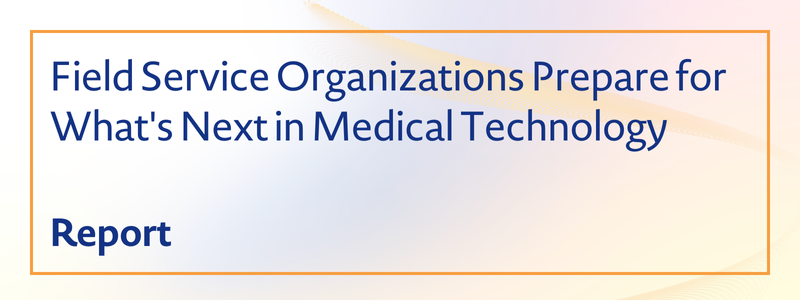Field Service Organizations Prepare for What's Next in Medical Technology

Field Service Organizations Prepare for What's Next in Medical Technology

(Source: Tom Claes on Unsplash)
Brought to you by WBR Insights.
The size of the global medical technology industry reached over 450 billion U.S. dollars in 2019. Established centers of this industry include the United States and Western Europe, but industry trends show that countries in Asia—especially China—are about to play a more prominent role in the years to come.
After a global pandemic year, the importance of medical technology has only continued to grow. In 2020 and beyond, organizations have struggled to meet the needs of the market. Medical systems are under greater amounts of stress than in recent memory, but they must continue to perform reliably and maintain minimal downtime.
Here, we'll explore some of the key steps medical service organizations are taking to prepare for a post-COVID medical technology environment.
Medical Technology Companies Are Investing in Connectivity
Like other businesses, field service organizations that maintain medical devices in clinical settings faced a tumultuous year in 2020. Restrictions due to social distancing guidelines added new challenges to the process of maintaining the uptime of medical devices, deploying technicians, and pursuing future technology initiatives.
Despite these challenges, medical device manufacturers and their field service departments have already made significant strides in deploying new connected medical devices and retrofitting existing assets with connected technologies.
According to a recent report by WBR Insights and the Field Service Medical conference series entitled "Medical Technology Field Service in the Post-COVID Healthcare Environment," mobile connectivity (61%), Bluetooth connectivity (59%), and Wi-Fi connectivity (54%) were the three technologies used in medical devices by most organizations.

These technologies have seen widespread use in consumer markets, and medical device manufacturers are making significant progress in deploying wireless technology for the benefit of both patients and clinicians. With these tools, manufacturers can connect with devices that are deployed in clinical settings, but also those in patient homes, to ensure they are functional and updated with the latest firmware. Both patients and clinicians rely on medical devices for care and clear diagnostics, so keeping them up to date is essential.
Medical device manufacturers are also making noteworthy progress in their integration of remote monitoring and repair technologies.

These types of solutions are made possible by mobile connectivity and are beginning to define how field service will be scheduled and carried out on medical devices in the future. With these tools, the manufacturer can collect real-time data on devices in the field and potentially initiate repairs without the cost of sending a human technician to a job site.
New Opportunities and Challenges Arise in the Homecare Market
Thanks to these new capabilities, there is more opportunity than ever in the homecare market. Homecare has taken on new importance since the start of the pandemic, as many patients were forced to engage in remote care and telehealth to maintain a safe distance from others.
As one of the fastest-growing marketplaces for medical equipment, the homecare market is also spurring innovation among healthcare device manufacturers. However, it may require manufacturers and field service departments to adapt their SLAs to meet the needs of consumers rather than clinical settings.
According to "Medical Technology Field Service in the Post-COVID Healthcare Environment," 55% of medical device field service teams offer substantially different service agreements for equipment in homecare environments when compared to equipment deployed in traditional clinical settings.

Respondents to the study that informed the report say that traditional clinical settings tend to be more professional and thus easier to work in. Technicians often have more resources at their disposal when working on-site, and the staff working at clinics generally have a better understanding how devices work.
Still, there are opportunities for service excellence in homecare settings.
Entering a patient's home represents a chance to become more involved in the patient experience. It also represents an opportunity for device manufacturers to educate patients about their support capabilities and the proper use of their devices. Many medical device organizations offer patient services to the end-users, but patients aren't often aware.
Patient-Centric Technology Will Drive Change
Most healthcare manufacturers and field service organizations view their relationships with customers in the medical field as important. But they are also beginning to recognize that their products and services play an important part in the patient experience as well. In many cases, their success in providing service int eh field can have direct impact on patient outcomes.
The Field Service Medical report showed that manufacturers are taking steps to make their products more user-friendly. They'll also focus heavily on patient education, providing patients with more access to knowledge resources and support services than ever before.
These choices aren't simply good for patients. They are also good for the brand. By building a trusting and informative relationship with patients, medical device field service organizations can demonstrate how integral their work is to creating better patient outcomes.
Register for the Next Field Service Event
As medical technology continues to evolve, so must the field service operations that maintain them and ensure patients receive an exceptional standard of care. After the COVID-19 pandemic, there is more emphasis on keeping patients connected and ensuring patients have access to care both in their communities and in their homes.
Advanced telemedicine tools, connected devices, and wearable technologies are just a few of the patient-centric innovations on the horizon in the healthcare industry, and field service organizations are adapting to advance them. To find out more about how medical technology field service is changing, don't miss the next virtual event from Field Service Medical conference series, happening from May 4th to May 5th online.
Visit the Field Service Medical Events page to download the latest agenda and reserve your spot.